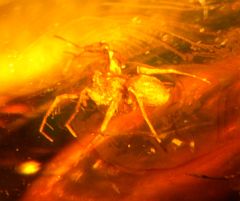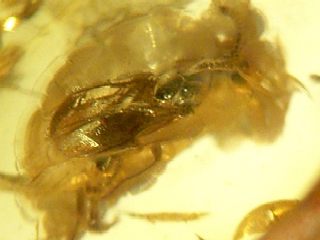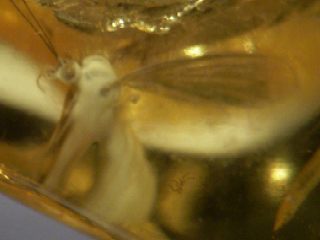
A really good example of a spider in amber
Click here for larger image


The above insect looks distorted. That's because it's very near the edge of this piece,
and the amber works like a lens. We think the white around the insect's body are fluids from the insect.
It's quite common, but we haven't been able to confirm this from other sources.
Click here for larger image.
What is Amber
It's not a stone, it's the resin from pine trees - if warmed it may produce an aromatic scent, a reminder of long lost forests (but don't try it at home, amber can be destroyed by heat). We all know how resin is soft at first, but slowly hardens. That's how it changes to a useable gem.
Sometimes it contains air-bubbles; scientists analyse them to learn about the earth's ancient atmosphere.
Rub amber with a dry cloth, and it becomes charged with electricity, it will then attract small pieces of paper. All our words associated with electricity come from Elektron, the Greek for Amber.
Natural Amber
Much amber is cloudy (this is often minute air bubbles), sometimes you may see inclusions, bits of petrified plant debris, and if you are really lucky you may even find a preserved insect. If buying such a piece be careful. We have seen several examples which look like insects even when examined under a 10x loupe, however when viewed under a microscope, they proved to be plant debris.
There are many fakes around, where modern insects have been embedded in amber. They are very hard to detect.
There are clues, look at the first picture on this page, the lack of the original colour of the spider,
is often an indication of age.
Second, note the way the spider's legs penetrate through a clear layer of the amber,
evidence of how the poor creature struggled to escape the resin.
Finally we know the source, and trust our supplier. And that goes for all the pictures on this page
Unlike gemstones, the resin is warm to the touch. It's also lighter than stone, so it's possible to make large spectacular pieces of jewellery, items which would be too heavy if made with any other material.
It comes in a range of colours, the most common is gold, but green is sometimes seen. There are variations of shade, sometimes the resin is a pale gold, while other pieces can be a rich dark gold. If you want to wear several pieces of amber jewellery together, make sure their colours complement each other.
For jewellery it looks best when clear, so most pieces have been clarity enhanced. By careful heating it is possible to clarify cloudy amber. Often "Sun spangles" (fractures which reflect the light) will be included in such enhanced amber. In all the cases I have mentioned the treatment is permanent.
Caring for amber.
It's soft, so don't let it rub against other jewellery, and don't wear it while doing physical work.
To clean it, wash it with detergent and water, using a very soft brush or a cloth. Do not soak it - even in water
The Greeks believed amber to be petrified sunlight



